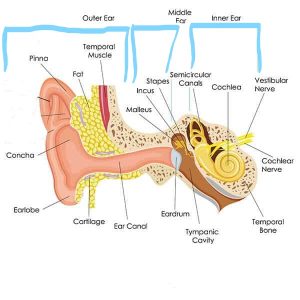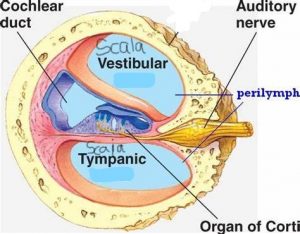Anatomy of EAR and Multiple choice question for NEET, GPAT, Staff Nurse, SSC exam, Lab Technician exam
The ear is divided in 3 regions- the outer ear, the middle ear, and the inner ear. The external or outer ear collects the sound waves and then heads them towards the tympanic membrane. the middle ear then conveys the vibrations to the oval window and the waves enters the inner ear which is filled with the receptors of hearing and equilibrium.

The outer ear
the outer ear consist of 3 parts-
- the pinna:- it is a flap to elastic cartilage and is covered with skin. the superior portion of pinna is the helix; and the inferior portion is known as lobule. ligaments and muscles attaches the pinna to the head.
- the auditory canal:- it is a curved tube which is about 2.5cm long and lies in the temporal bone; it heads toward the tympanic membrane.
- the eardrum:- the eardrum or tympanic membrane is a semitransparent partition between the external and the middle ear. it is covered by the epidermis and lined by simple cuboidal epithelium.
Near the exterior opening, the auditory canal contains few hairs and specialized gland. they are called the ceruminous glands. these glands secrete earwax known as cerumen.
The middle ear
It is a small air filled cavity in the temporal bone and is lined by epithelium. The middle ear is separated from outer ear by the eardrum. and it is separated by the inner ear through a thin bony partition that contains two small openings called the oval window and round window. The middle ear consist of 3 auditory ossicles or auditory bones which are joined by synovial joint. these are-
- Malleus:- the handle of malleus attaches to the internal surface of tympanic membrane. The head of malleus articulates with the body of incus.
- Incus:- the incus articulates with the head of stapes.
- Stapes:- the base of stapes fits into the oval window.
just below the oval window, is the another opening known as the round window. The anterior wall of middle ear contains an opening that leads directly into the auditory tube. It is commonly known as eustachian tube.
The inner ear
It is also known as labyrinth because it consist of a series of complicated canals. structurally the inner ear is divided in 2 portions- the outer bony labyrinth which surrounds the inner membranous labyrinth. The bony labyrinth is divided in 3 parts- the semicircular canals, vestibule and the cochlea. the bony labyrinth is filled with perilymph and the membranous labyrinth is filled with endolymph.
- The Vestibule:- it is oval portion of bony labyrinth. The membranous labyrinth inside the vestibule consist of 2 sacs- the utricle and saccule which are connected by small duct.
- Semi-circular Canals:- there are 3 semicircular canals which are named according to their positions like; the anterior, posterior and lateral semicircular canals. At one end of the canal is the swollen enlargement called ampulla. Inside the canals are the semicircular ducts which connects to the utricle of vestibule.
- Cochlea:- cochlea lies anterior to the vestibule. it resembles the shape of a snail’s shell. the cochlea is divided in 3 parts-
- the cochlear duct:- it is the inner part of the cochlea which is filled with endolymph.
- scala vestibuli:- the channel above the cochlear duct is known as scala vestibuli and it ends at the oval window
- scala tympani:- the channel below the cochlear duct is scala tympani and ends at the round window.

The vestibular membrane separates cochlear duct from scala vestibuli; and the basilar membrane separates cochlear duct from scala tympani.
Resting on the basilar membrane is the organ of corti which consist of receptors for hearing. the organ of corti consist of hair cells and supporting cells. there are two groups of hair cells: the inner hair cells which are arranged in single row and the outer hair cells which are ranged in three rows. the tectorial membrane is a flexible gelatinous membrane which covers the hairs of organ of corti.
Multiple choice questions(MCQs)
1. What is auricle also known as?
A. eardrum b. pinna
C. auditory tube D. round window
2. Where are the ceruminous glands situated?
A. exterior opening of auditory tube
B. anterior opening of auditory tube
C. anterior opening of round window
D. exterior opening of round window
3. what is the function of cerumen?
A. prevents damage to the delicate skin B. prevent water entry
C. protection from insects D. all of the above
4. Which of the following auditory bone is attached to the oval window?
A. malleus B. incus
C. stapes D. none of the above
5. Which of the following statement is NOT true?
A. semicircular ducts are filled with perilymph
B. utricles and saccule are two sac like structures
C. cochlea makes almost 3 turns around bony core
D. basilar membrane separates cochlear duct from scala tympani
6. What is the swollen enlargement on one side of semicircular canal called?
A. semicircular duct B. ampulla
C. vestibule D. cochlea
7. Which membrane encloses or surrounds the round window?
A. tectorial membrane B. basilar membrane
C. Vestibular membrane D. none of the above
8. Match the following-
A. semicircular canal 1. Contains semicircular ducts
B. cochlea 2. Contains Organ of corti
C. vestibule 3. Contains saccule and utricle
D. pinna 4. Contains helix and lobule
9. Which of the following is NOT the part of bony labyrinth?
A. vestibule B. cochlea
C. semicircular canals D. utricle
10. What is the function of tectorial membrane?
A. protects the utricle B. protects the semicircular ducts
C. covers the hairs cells of organ of corti D. secretion of cerumen
ANSWERS:-
1. pinna
2. exterior opening of auditory tube
3. all of the above
4. stapes
5. semicircular ducts are filled with perilymph
6. ampulla
7. none of the above; it is the secondary tympanic membrane
8. A – 1 B – 2 C – 3 D – 4
9. utricle
10. covers the hair cells of organ of corti
Participate in Online FREE GPAT TEST: CLICK HERE
Participate in Online FREE Pharmacist TEST: CLICK HERE
Participate in Online FREE Drug Inspector TEST: CLICK HERE
REFRENCE:- Gerard J. Tortora -Principles of anatomy and physiology; edition twelfth ; page no.-: 620-623.